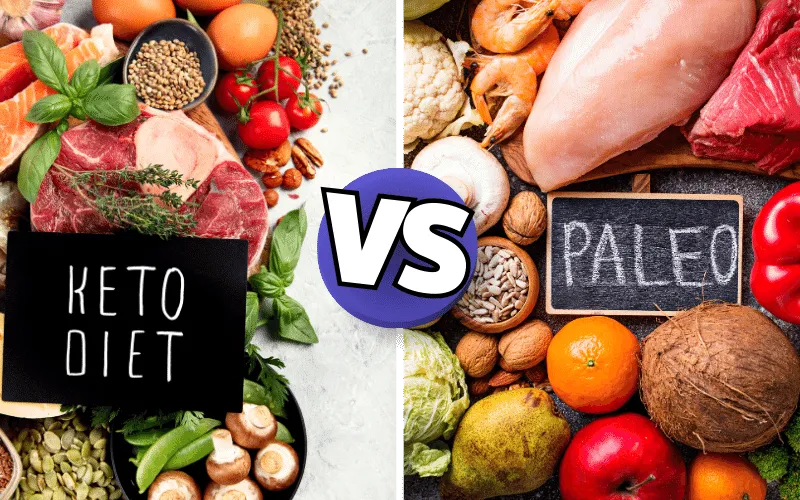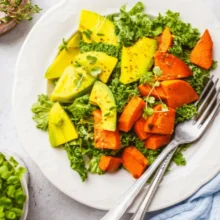Keto vs Paleo: Which is the Best Diet for Sustainable Weight Loss in 2024?

In today’s world of health and fitness, two popular diet trends dominate the conversation: keto and paleo. As individuals strive to achieve their weight loss goals, understanding the differences between “keto vs paleo” becomes crucial. Both diets promise impressive results, but which one is the right choice for you?
This article aims to provide a detailed comparison of “keto vs paleo,” guiding you through the principles, benefits, and challenges of each diet. By the end of this comparison, you’ll have a clearer understanding of which diet might be better suited to your weight loss journey. Let’s dive into the fascinating world of keto and paleo diets and discover how they can help you achieve your health and fitness goals.
Table of Contents
What is the Keto Diet?
Understanding the keto diet is essential when comparing “keto vs paleo.” This section delves into the fundamentals of the ketogenic diet, its benefits, and challenges.
Definition and Origin
The ketogenic diet, commonly known as the keto diet, is a high-fat, low-carbohydrate diet designed to shift the body’s metabolism from relying on carbohydrates to burning fats for energy. Originating in the 1920s as a treatment for epilepsy, the keto diet has gained popularity for its effectiveness in weight loss and other health benefits.
How It Works
The keto diet works by inducing a state of ketosis, where the body burns fat instead of glucose for fuel. This metabolic state is achieved by drastically reducing carbohydrate intake and increasing fat consumption. In ketosis, the liver converts fats into ketones, which serve as an alternative energy source for the body.
Typical Foods
On the keto diet, the focus is on high-fat, moderate-protein, and low-carbohydrate foods. Common foods include:
- Meats and poultry
- High-fat dairy products like cheese and butter
- Nuts and seeds
- Low-carb vegetables such as leafy greens
- Healthy fats like olive oil and avocado
Benefits
The keto diet offers several benefits, including:
- Rapid weight loss: By burning fat for fuel, the keto diet can lead to significant weight loss.
- Improved mental clarity: Many people report better focus and mental sharpness on the keto diet.
- Enhanced energy levels: Stable blood sugar levels can result in sustained energy throughout the day.
Challenges
Despite its benefits, the keto diet also presents challenges:
- Keto flu: Initial side effects such as headaches, fatigue, and nausea, often referred to as the keto flu.
- Nutrient deficiencies: The restrictive nature of the diet can lead to deficiencies in certain vitamins and minerals.
- Strict adherence: Maintaining ketosis requires strict adherence to the diet, which can be difficult for some people.
What is the Paleo Diet?
In the comparison of “keto vs paleo,” understanding the paleo diet is just as important. This section explores the basics of the paleo diet, its benefits, and challenges.
Definition and Origin
The paleo diet, also known as the Paleolithic or caveman diet, is based on the principle of eating foods that our ancestors would have consumed during the Paleolithic era. The idea is to mimic the eating habits of early humans, focusing on whole, unprocessed foods while eliminating modern agricultural products and processed items.
How It Works
The paleo diet works by encouraging the consumption of foods that humans would have hunted or gathered. This includes a variety of meats, fish, fruits, vegetables, nuts, and seeds. The diet excludes grains, legumes, dairy, and processed foods, aiming to improve health and support weight loss by returning to a more natural way of eating.
Typical Foods
On the paleo diet, the focus is on whole, unprocessed foods. Common foods include:
- Lean meats and poultry
- Fish and seafood
- Fresh fruits and vegetables
- Nuts and seeds
- Healthy fats from avocados and olive oil
Benefits
The paleo diet offers several benefits, including:
- Improved digestion: By eliminating processed foods and grains, many people experience better digestive health.
- Reduced inflammation: The emphasis on whole, nutrient-dense foods can help reduce inflammation in the body.
- Enhanced overall health: The diet’s focus on natural foods supports overall health and well-being.
Challenges
While the paleo diet has its benefits, it also presents challenges:
- Restrictive nature: The elimination of grains, legumes, and dairy can make it difficult to follow for some people.
- Nutritional balance: Ensuring a well-rounded intake of nutrients can be challenging without careful meal planning.
- Social limitations: Eating out or attending social gatherings can be more challenging due to the dietary restrictions.
Keto vs Paleo: Key Differences
When comparing “keto vs paleo,” it’s important to understand the key differences that set these diets apart. This section highlights the main distinctions between the two diets in terms of macronutrient composition, allowed foods, health effects, and sustainability.
Macronutrient Composition
One of the primary differences between keto and paleo is their macronutrient composition. The keto diet is high in fats, moderate in proteins, and very low in carbohydrates. This specific ratio is designed to induce ketosis. In contrast, the paleo diet does not have a strict macronutrient ratio. Instead, it emphasizes whole foods and allows for a more balanced intake of fats, proteins, and carbohydrates.
Allowed Foods
The types of foods allowed on keto vs paleo differ significantly. On the keto diet, the focus is on high-fat, low-carb foods. This includes fatty cuts of meat, full-fat dairy, and low-carb vegetables. On the other hand, the paleo diet emphasizes eating whole, unprocessed foods that our ancestors would have consumed. This means a variety of lean meats, fish, fruits, vegetables, nuts, and seeds, while excluding dairy, grains, and legumes.
Health Effects
Both diets offer unique health benefits, but they also have different effects on the body. The keto diet is known for its rapid weight loss potential and improved mental clarity due to ketosis. However, it can also lead to side effects like the keto flu and nutrient deficiencies if not managed properly. The paleo diet, with its emphasis on whole foods, can improve digestion, reduce inflammation, and support overall health. However, its restrictive nature can make it challenging to get a balanced intake of all nutrients.
Sustainability
When it comes to sustainability, keto vs paleo offers different experiences. The keto diet requires strict adherence to maintain ketosis, which can be difficult for some people to sustain long-term. The paleo diet, while also restrictive, offers more flexibility in food choices and may be easier to maintain as a lifestyle rather than a temporary diet. Both diets require careful planning and commitment, but individual preferences and lifestyle can influence which one is more sustainable.
Keto vs Paleo: Which is Better for Weight Loss?
When considering “keto vs paleo” for weight loss, it’s important to evaluate the effectiveness of each diet. This section explores the weight loss potential, scientific studies, and the importance of personalization in choosing the right diet.
Effectiveness
Both the keto and paleo diets are popular for their weight loss benefits, but they work in different ways. The keto diet promotes rapid weight loss by inducing ketosis, where the body burns fat for energy instead of carbohydrates. This metabolic shift can result in significant fat loss. The paleo diet supports weight loss by encouraging the consumption of whole, nutrient-dense foods and eliminating processed foods, which can lead to a natural reduction in calorie intake.
Scientific Studies
Several studies have examined the weight loss effects of keto vs paleo. Research indicates that the keto diet can lead to quicker initial weight loss due to the body’s adaptation to burning fat. However, studies also show that the paleo diet can be effective for long-term weight management by promoting healthier eating habits and reducing inflammation. Both diets have their strengths, and scientific evidence supports their efficacy for weight loss, depending on individual adherence and lifestyle.
Personalization
The choice between keto vs paleo for weight loss often comes down to personal preferences and how the body responds to each diet. Some individuals may find the high-fat, low-carb approach of the keto diet more suitable for their metabolism and lifestyle, while others may prefer the balanced, whole-food focus of the paleo diet. Personalization is key—consider your own dietary preferences, health goals, and how your body reacts to different foods when choosing the right diet.
Keto vs Paleo: Potential Health Risks
In the debate of “keto vs paleo,” it’s crucial to consider the potential health risks associated with each diet. This section examines the possible nutrient deficiencies, long-term health implications, and the importance of consulting with healthcare professionals.
Nutrient Deficiencies
Both the keto and paleo diets have the potential to cause nutrient deficiencies if not properly managed. The keto diet, with its strict limitation on carbohydrates, may lead to deficiencies in essential nutrients such as fiber, vitamins, and minerals commonly found in fruits, vegetables, and whole grains. Similarly, the paleo diet, which excludes dairy and grains, might result in insufficient calcium, vitamin D, and certain B vitamins. It’s important for individuals on either diet to plan their meals carefully to ensure they are getting a well-rounded intake of nutrients.
Long-Term Health
Considering the long-term health effects of “keto vs paleo” is essential. The keto diet’s high-fat content, particularly if it includes unhealthy fats, can raise concerns about cardiovascular health over time. On the other hand, the paleo diet, with its emphasis on lean meats and whole foods, is generally considered healthier in the long run. However, its restrictive nature can still pose challenges, particularly in maintaining balanced nutrition over the years. Both diets can be sustainable with proper planning and attention to nutritional needs.
Consulting with Professionals
Before embarking on either the keto or paleo diet, it is highly recommended to consult with healthcare professionals. A doctor or registered dietitian can help tailor the diet to individual health needs, monitor for potential deficiencies, and provide guidance on maintaining a balanced diet. Professional advice can help mitigate the risks associated with both diets and ensure a safer and more effective weight loss journey.
Practical Tips for Choosing Between Keto and Paleo
When deciding between “keto vs paleo,” practical considerations can help determine which diet is better suited for your lifestyle and goals. This section offers tips on lifestyle considerations, food preferences, and the trial and error process.
Lifestyle Considerations
Choosing between keto and paleo often depends on your lifestyle. The keto diet requires careful monitoring of macronutrient intake to maintain ketosis, which can be challenging for those with busy schedules or social eating habits. The paleo diet, with its emphasis on whole foods, may be easier to incorporate into everyday life without the need for meticulous tracking. Consider your daily routine, cooking habits, and social activities when deciding which diet aligns better with your lifestyle.
Food Preferences
Your food preferences play a significant role in the success of any diet. If you enjoy high-fat foods like avocados, nuts, and cheese, the keto diet might be more appealing. Conversely, if you prefer a variety of fruits, vegetables, and lean meats, the paleo diet could be a better fit. Choosing a diet that aligns with your taste preferences can increase the likelihood of long-term adherence and satisfaction.
Trial and Error
Finding the right diet often involves a period of trial and error. Start by experimenting with both keto and paleo for a few weeks each. Pay attention to how your body responds, including changes in energy levels, digestion, and overall well-being. This process can help you identify which diet feels more sustainable and effective for your individual needs. Remember, the best diet is one that you can maintain comfortably over time.
Success Stories: Real-Life Examples
Real-life success stories can provide valuable insights when comparing “keto vs paleo.” This section shares brief success stories of individuals who have achieved their weight loss goals on each diet, highlighting key takeaways and lessons learned.
Keto Success Stories
Many individuals have experienced significant weight loss and health improvements on the keto diet. For instance, Sarah, a 35-year-old mother of two, lost 40 pounds in six months by following a strict keto regimen. She reported increased energy levels and better mental clarity, which helped her manage her busy lifestyle. Sarah’s key takeaway is the importance of meal planning and tracking macronutrients to stay in ketosis.
Another success story comes from John, a 45-year-old businessman, who struggled with weight gain due to a sedentary lifestyle. By adopting the keto diet, John lost 30 pounds in four months and noticed a reduction in his blood pressure and cholesterol levels. John’s lesson learned is the need to stay committed to the diet, especially during social gatherings, to maintain ketosis and achieve desired results.
Paleo Success Stories
The paleo diet has also led to remarkable transformations. Lisa, a 28-year-old fitness enthusiast, embraced the paleo diet and lost 25 pounds in three months. She found the diet easy to follow due to its focus on whole foods and reported improved digestion and reduced bloating. Lisa’s key takeaway is to enjoy a variety of paleo-approved foods to keep the diet enjoyable and sustainable.
Mark, a 50-year-old teacher, successfully managed his weight and improved his overall health with the paleo diet. By eliminating processed foods and focusing on lean meats and vegetables, Mark lost 35 pounds in five months. He also experienced increased energy and fewer digestive issues. Mark’s lesson learned is the importance of meal prepping to ensure access to healthy, paleo-friendly meals throughout the week.
Key Takeaways
Both keto and paleo success stories highlight the potential for significant weight loss and health improvements. The key takeaways from these stories are:
- Commitment and consistency are crucial for achieving and maintaining results.
- Meal planning and preparation can make adhering to either diet easier.
- Listening to your body and adjusting the diet to fit your personal needs can enhance long-term success.
In the debate of “keto vs paleo,” both diets offer unique benefits and challenges. The keto diet, with its focus on high-fat and low-carb intake, can lead to rapid weight loss and improved mental clarity through ketosis. However, it requires strict adherence to maintain this metabolic state, which can be challenging for some individuals.
On the other hand, the paleo diet emphasizes whole, unprocessed foods, mimicking the eating habits of our ancestors. This diet can improve digestion, reduce inflammation, and support overall health. Its flexibility with macronutrients and focus on natural foods make it a sustainable option for many.
Ultimately, the choice between keto and paleo depends on your personal health goals, lifestyle, and preferences. Both diets can be effective for weight loss and improving health, but it’s essential to consider how each fits into your daily routine and long-term objectives. Consulting with healthcare professionals can provide personalized guidance to ensure you’re making the best choice for your needs.
As you embark on your weight loss journey, remember that both keto and paleo require commitment and consistency. By understanding the key differences and benefits of “keto vs paleo,” you can make an informed decision that aligns with your goals and sets you on the path to success.
FAQs About Keto vs Paleo
What are the main differences between keto and paleo diets?
The primary differences between keto and paleo diets lie in their macronutrient composition and food restrictions. The keto diet is high in fats, moderate in proteins, and very low in carbohydrates to induce ketosis. The paleo diet focuses on whole, unprocessed foods, including lean meats, fish, fruits, vegetables, nuts, and seeds, while excluding grains, legumes, and dairy.
Which diet is better for weight loss: keto or paleo?
Both keto and paleo diets can be effective for weight loss, but their effectiveness depends on individual preferences and how strictly the diet is followed. The keto diet can lead to rapid weight loss through ketosis, while the paleo diet promotes weight loss by eliminating processed foods and focusing on nutrient-dense, whole foods.
Are there any potential health risks associated with keto and paleo diets?
Both diets have potential health risks if not properly managed. The keto diet can lead to nutrient deficiencies, the keto flu, and cardiovascular concerns due to its high-fat content. The paleo diet may also result in nutrient deficiencies, particularly in calcium and vitamin D, due to the exclusion of dairy and grains.
Can I combine elements of both keto and paleo diets?
Yes, it’s possible to combine elements of both diets, often referred to as a “keto-paleo” or “paleo-keto” approach. This hybrid diet focuses on high-fat, low-carb foods while emphasizing whole, unprocessed foods. However, it still requires careful planning to ensure balanced nutrition and adherence to dietary principles.
How do I know which diet is right for me?
Choosing between keto vs paleo depends on your health goals, lifestyle, and personal preferences. Consider factors such as your daily routine, food preferences, and how your body responds to different diets. Consulting with a healthcare professional or registered dietitian can also provide personalized guidance.
What can I expect during the initial phase of the keto diet?
During the initial phase of the keto diet, some people experience symptoms known as the “keto flu,” which can include headaches, fatigue, nausea, and irritability. These symptoms usually subside within a week as the body adjusts to burning fat for fuel. Staying hydrated, getting enough electrolytes, and gradually reducing carbohydrate intake can help mitigate these effects.
Is it difficult to maintain the paleo diet long-term?
Maintaining the paleo diet long-term can be challenging due to its restrictive nature, especially the exclusion of grains, legumes, and dairy. However, many people find it sustainable by focusing on a variety of whole, unprocessed foods and planning meals ahead of time. Flexibility within the diet, such as occasionally including non-paleo foods, can also help with long-term adherence.
For more insights on achieving a healthier lifestyle, check out our other informative articles on topics such as Body Detoxification, Healthy Eating, Quick Weight Loss, and Weight Loss Diets. Dive deeper to find strategies and tips that can help you reach your wellness objectives!




